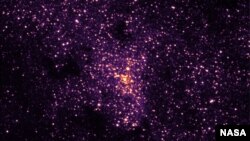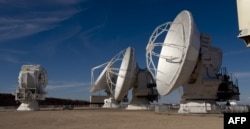Astronomers have found new evidence for the existence of a mid-sized black hole, considered the missing link in the evolution of supermassive black holes.
Astronomers in Japan found the possible black hole in our own Milky Way galaxy, a long-theorized object which is bigger than the small black holes formed from a single star, but still much smaller than giant black holes such as the one at the center of the Milky Way.
Black holes are difficult to find because they do not emit any light. However, scientists can detect them by their influence on nearby objects.
The astronomers in Japan found new evidence of the so-called intermediate-mass black hole when they turned a powerful telescope in Chile's Atacama desert on a gas cloud near the center of the Milky Way. The gases in the cloud move at unusual speeds, and the scientists believed they were being pulled by immense gravitational forces. They say the gravitational force is likely caused by a black hole measuring about 1.4 trillion kilometers across.
The findings are published in the journal Nature Astronomy.
Theoretical studies predict at least 100 million of these small black holes should exist in the Milky Way, however only about 60 have been found.
The possible mid-sized black hole is much smaller than the supermassive black hole that is located in the center of the galaxy, known as Sagittarius A, which weighs as much as 400 million suns.
"This is the first detection of an intermediate-mass black hole candidate in the Milky Way galaxy," said the study's leader, Tomoharu Oka from Keio University, Japan.
If confirmed, the intermediate-mass black hole could help explain how supermassive black holes operate. One theory is that supermassive black holes, which are at the center of most massive galaxies, are formed when smaller black holes steadily coalesce into larger ones. However, until now no definitive evidence has existed for intermediate-mass black holes that could indicate a middle step between the small and massive black holes already detected.
Researchers say they will continue to study the intermediate-mass black hole candidate in the hope of confirming its existence.






